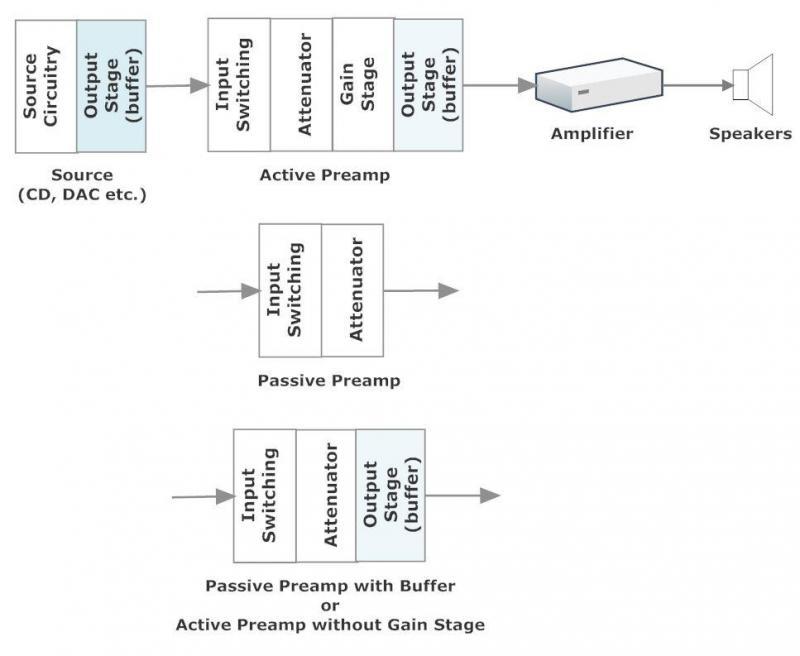Active vs Passive Preamp Debate
The Active vs Passive Preamp Debate
If you peruse a few online audio forums you will ineveitably find high performance audio enthusiasts disagreeing on many audio subjects. It’s what we do :). One such topic is the debate over which type of preamp is better – active or passive?
Someone tries a passive preamp, is less than thrilled with the result, and thereafter relates their experience to others either explicitly or implicitly sending the message that passive preamps aren’t quite up to the job compared to active preamps. Another person tries a passive preamp in their system, experiences audio nirvana, and thereafter extolls the virtues of passive preamps suggesting that all naysayers are simply wrong if they disagree.
As a reader and interested audiophile, how are we expected to make sense of these apparently polar opposite views? Who is right?
In this article we take a closer look at what’s going on behind the active vs passive preamp debate and hopefully develop a better understanding so we can all make wiser choices.
It’s All About The Energy
What do we really mean when we say “the audio signal”?
When we send an audio signal from a source, such as a DAC, through a preamp to an amplifier what exactly are we sending? We’re sending energy, or to be more precise, we’re sending power, electrical power. In physics, electrical power is defined as the mathematical product of voltage multiplied by current (P = V*I).
In audio, the actual music is represented by the voltage waveform. This voltage (the “V”) must be conveyed (moved along a wire) by a current that carries it (the “I”). It’s literally this V*I product that is the musical energy. Of course it’s never that simple. The “V” isn’t just one value, it’s the composite of many values spread unevenly across the the audible frequency spectrum of 20-20,000 hertz. At every instant of time the current “I” that’s carrying that spectrum of voltage “V” must keep up with that voltage and not let the voltage sag (droop) or get out of lock-step (out of phase) with the voltage or else the audio signal energy will be reduced or degraded.
Audio Energy Originates At The Source
Whether your source of music is a DAC, a CD player, a phono stage, a tuner or some other source device, that device’s ability to deliver the musical energy sets the upper limit of how good your system will sound.
It’s a fundamental misconception that any audio component can “improve” on the original audio signal. Every audio component in a signal chain does some degree of harm. The objective, or “trick” if you prefer, is to do the least amount of harm.
It’s the old “weakest link in the chain” scenario. The shortest chain with the fewest yet strongest links will perform the best. And the first link in any audio chain is the source.
The quote below from www.high-endaudio.com speaks directly to how relevant the performance of a source component is to the passive vs active debate.
“Only when the original signal source has the required energy to directly drive the power amplifier, without any sonic compromises, can a passive line stage ever be used with complete success, since the only function remaining at that point is signal attenuation. This basic technical fact is why audiophiles talk past each other when they argue which is better; passive or active. This is because the actual results completely depend on the specific system in question; in particular the source’s energy output and the amplifier’s energy input requirement.
Those audiophiles who have the sources with the required energy (a minority), will not be able to understand how anyone would want to listen to the inevitable sonic degradations of any active line stage, when there are no corresponding sonic benefits. Meanwhile, those audiophiles whose sources do not have the required energy (a majority), will not be able to understand how anyone would prefer to avoid some relatively minor audible problems while simultaneously ignoring the much larger and more easily noticeable sonic benefits they are experiencing. Both sides are undeniably correct, because they are experiencing two very different realities, though all of their experiences are consistent with the laws of acoustics and electronics. ” – https://www.high-endaudio.com/RC-Linestages.html
The takeaway here is twofold.
- If you have a source with a sufficiently robust output stage capable of delivering the required energy, a passive preamp will most likely yield excellent results.
- If your source has a weak output stage, an active preamp will likely mitigate this weakness to some extent with better sonic results than a passive preamp.
The Active Preamp
To better understand all this, let’s take a closer look at the differences between an active and passive preamp. In the diagram below we see a typical audio signal chain including the source, active preamp, amp and finally the speaker.
The functional blocks of a typical active preamp are as follows:
Input Switching – Enables selection between multiple sources (only one source is shown in the diagram here).
Attenuator – Provides volume control (voltage division)
Gain Stage – Provides some amount of amplification (voltage multiplication) to ensure that the output voltage is sufficient regardless of the source voltage and the amplifier sensitivity.
Output Stage (Buffer) – Isolates the preamp input sections from the preamp output and provides a low output impedance buffer with robust current delivery capacity.
Notice that with an active preamp we now have 2 output (buffer) stages in series. The first belongs to the source. The second belongs to the active preamp. This raises a legitimate question. Why have 2 output stages in series? Why not just have one very good output stage in the source?
The Passive Preamp
If we use a passive preamp instead of an active preamp we get rid of both a gain stage and the second output stage. Since most sources today have sufficient line stage output voltage and most amps have correspondingly sufficient input sensitivity, we aren’t going to miss not having a gain stage.
With a passive preamp we are now relying on the output stage of the source to drive the required energy through the passive preamp’s attenuator to the amplifier by itself. What if that source isn’t up to the job?
The Buffered Passive Preamp
If the source is struggling to deliver robust energy through the passive preamp we do have another option; add a buffer (output stage) to the passive preamp. How is this different from an active preamp? It’s different insofar as we avoid the complexity and negative aspects of a preamp gain stage.
Wheher we call this a passive preamp with a buffer or an active preamp without a gain stage, is mostly a matter of semantics and marketer’s perogative.
The advantage of a buffered passive preamp is that it helps mitigatge the shortcomings of a weak source with the least amount of additional hardware. We avoid a complex and noisy gain stage and its need for a commensurate high performance power supply.
Less processing and manipulation of the audio signal more often than not results in a better sounding system. When your source isn’t a good fit for a pasive preamp, a buffered passive preamp may be the ideal solution.
Tortuga Audio offers a line of both single-ended and balanced passive preamps together with matching preamp buffers for when a passive preamp alone is not enough.
More general information on passive preamps and buffers can be found in the articles listed below:
Is A Passive Preamp Right For You?
Is A Preamp Buffer Right For You?







